What is 3/20 + 2/8?

|
Here's how you add
|
||||||||||||||||||||||||||||||||||||||||||||||
Step 1We still have different denominators (bottom numbers), though, so we need to get a common denominator. This will make the bottom numbers match. Multiply the denominators together first. Now, multiply each numerator by the other term's denominator. Now we multiply 3 by 8, and get 24, then we multiply 20 by 8 and get 160. Now for the second term. You multiply 2 by 20, and get 40, then multiply 20 by 8 and get 160. This gives us a new problem that looks like so:
|
||||||||||||||||||||||||||||||||||||||||||||||
Step 2Since our denominators match, we can add the numerators. 24 + 40 = 64 That gives us an answer of
|
||||||||||||||||||||||||||||||||||||||||||||||
Step 3Can this fraction be reduced? First, we attempt to divide it by 2... Are both the numerator and the denominator evenly divisible by 2? Yes! So we reduce it:
Let's try dividing by that again... Are both the numerator and the denominator evenly divisible by 2? Yes! So we reduce it:
Let's try dividing by that again... Are both the numerator and the denominator evenly divisible by 2? Yes! So we reduce it:
Let's try dividing by that again... Are both the numerator and the denominator evenly divisible by 2? Yes! So we reduce it:
Let's try dividing by that again... Are both the numerator and the denominator evenly divisible by 2? Yes! So we reduce it:
Let's try dividing by that again... Nope! So now we try the next greatest prime number, 3... No good. 3 is larger than 2. So we're done reducing. There you have it! Here's the final answer to 3/20 + 2/8
|